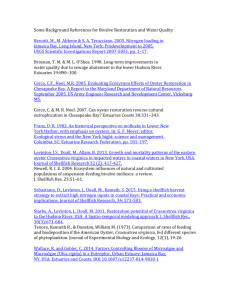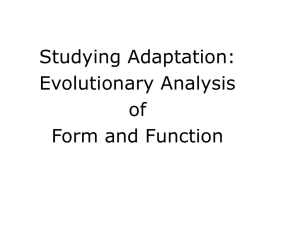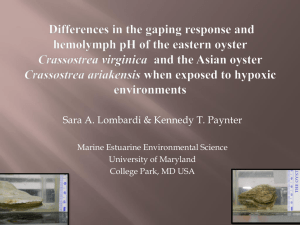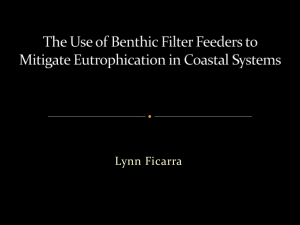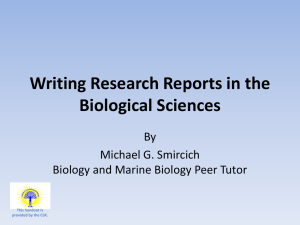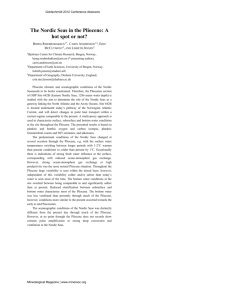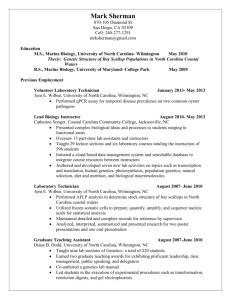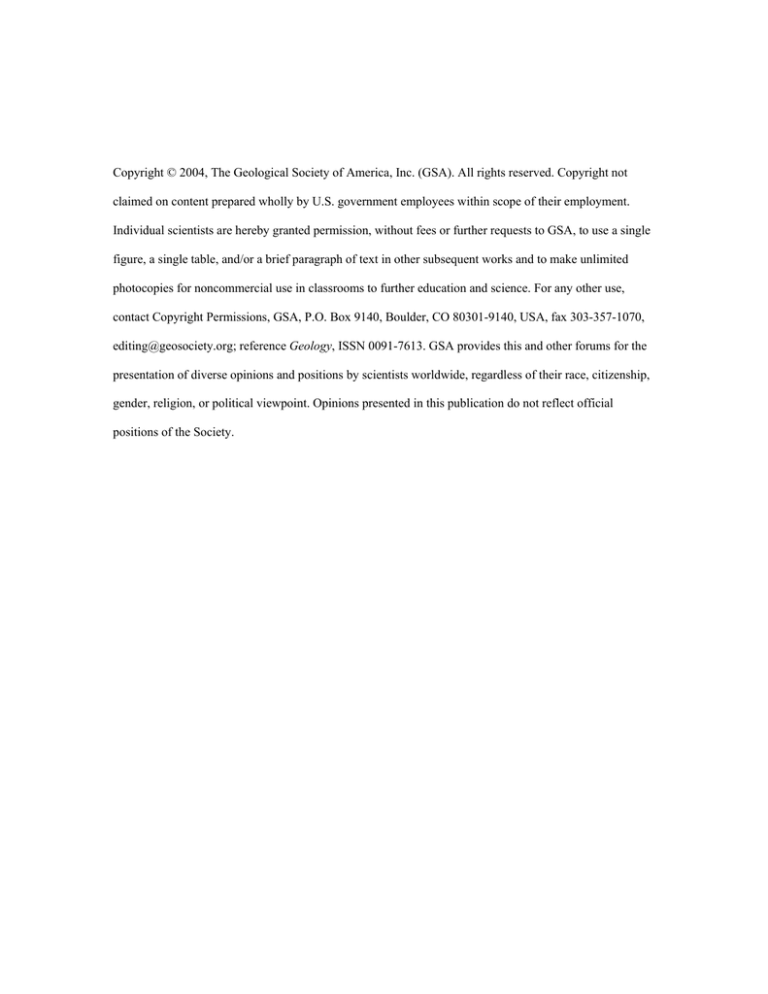
Copyright © 2004, The Geological Society of America, Inc. (GSA). All rights reserved. Copyright not
claimed on content prepared wholly by U.S. government employees within scope of their employment.
Individual scientists are hereby granted permission, without fees or further requests to GSA, to use a single
figure, a single table, and/or a brief paragraph of text in other subsequent works and to make unlimited
photocopies for noncommercial use in classrooms to further education and science. For any other use,
contact Copyright Permissions, GSA, P.O. Box 9140, Boulder, CO 80301-9140, USA, fax 303-357-1070,
editing@geosociety.org; reference Geology, ISSN 0091-7613. GSA provides this and other forums for the
presentation of diverse opinions and positions by scientists worldwide, regardless of their race, citizenship,
gender, religion, or political viewpoint. Opinions presented in this publication do not reflect official
positions of the Society.
Extinction of a fast-growing oyster and changing ocean circulation
in Pliocene tropical America
Michael X. Kirby* Scripps Institution of Oceanography, University of California, San Diego, La Jolla, California 92093, USA
Jeremy B.C. Jackson Scripps Institution of Oceanography, University of California, San Diego, La Jolla, California 92093,
USA, and Center for Tropical Paleoecology and Archaeology, Smithsonian Tropical Research Institute,
Box 2072, Balboa, Republic of Panamá
ABSTRACT
Ocean circulation changed profoundly in the late Cenozoic
around tropical America as a result of constriction and final closure of the Central American seaway. In response, regional planktonic productivity is thought to have decreased in the Caribbean
Sea. Previous studies have shown that shallow-marine communities
reflect these changes by reorganizing from a suspension-feeder–
dominated community to a more carbonate-rich, phototrophicbased community. Although changes in diversity, abundance, and
body size of various shallow-marine invertebrates have previously
been examined, no study has specifically used growth rate in suspension feeders to examine the effect that changes in ocean circulation may have had on shallow-marine communities. Here we
show that a fast-growing oyster went extinct concurrently with
changes in ocean circulation and planktonic productivity in the
Pliocene. Faster-growing Crassostrea cahobasensis went extinct,
whereas slower-growing Crassostrea virginica and columbiensis
survived to the Holocene. Miocene–Pliocene C. cahobasensis grew
522% faster in shell carbonate and 251% faster in biomass relative
to Quaternary C. virginica and C. columbiensis. Although differences in growth are due to proximate differences in environment,
the disappearance of faster-growing C. cahobasensis from shallowmarine environments and the continued survival of slower-growing
C. virginica and C. columbiensis in marginal-marine environments
(e.g., estuaries, lagoons) is consistent with the view that concurrent
changes in ocean circulation and declining primary production resulted in the restriction of Crassostrea to marginal-marine
environments.
Keywords: Central American seaway, paleoproductivity, growth rate,
oyster, Crassostrea.
INTRODUCTION
Shallow-marine communities around tropical America underwent
significant change in the late Cenozoic (Coates et al., 1992). These
changes include increased speciation and extinction of mollusks (Allmon, 1992; Allmon et al., 1993; Jackson et al., 1993, 1996, 1999),
changes in the body size of various mollusks (Jackson et al., 1996;
Roopnarine, 1996; Anderson, 2001), decrease in the abundance of suspension feeders and their predators (Todd et al., 2002), changes in coral
diversity and reef structure (Budd et al., 1996; Collins et al., 1996),
and the disappearance of some highly specialized molluscan symbioses
(Vermeij, 1998). A regional decline in planktonic productivity related
to changing ocean circulation associated with final closure of the Central American seaway has been implicated in these biotic changes
(Woodring, 1966; Vermeij, 1978; Vermeij and Petuch, 1986; Allmon,
1992; Allmon et al., 1993; Jackson et al., 1993; Todd et al., 2002).
Although open-ocean sediment cores from both the Pacific and Caribbean Basins show profound changes in ocean circulation resulting from
constriction of the Central American seaway (Emiliani et al., 1972;
*Present address: Center for Tropical Paleoecology and Archaeology,
Smithsonian Tropical Research Institute, Box 2072, Balboa, Republic of
Panamá.
TABLE 1. LATE CENOZOIC CRASSOSTREA SPECIES FROM TROPICAL
AMERICA
Species
Locality
C. columbiensis
El Rompı́o, Panamá
C. virginica
Orinoco Delta, Venezuela
C. virginica
Saline Bay, Trinidad
C. virginica
Paraguaipoa, Venezuela
C. virginica
Colón, Panamá
C. virginica
Gatun Locks, Panamá
C. columbiensis
Miraflores Locks, Panama
C. virginica
Falcon, Venezuela
C. virginica
Barbados
C. virginica
Panamá
C. virginica
Limón, Costa Rica
C. virginica
Trinidad
C. cahobasensis
Rio Seco, Venezuela
Crassostrea aff.
Trinidad
C. virginica
Crassostrea aff. Araya Peninsula, Venezuela
C. virginica
C. cahobasensis
San Rafael, Nicaragua
Crassostrea aff.
Jamaica
C. virginica
C. cahobasensis
Monte Oscuro, Venezuela
C. cahobasensis
Las Lomas, Venezuela
C. cahobasensis Quebrada La Vela, Venezuela
C. cahobasensis
Araurima, Venezuela
C. cahobasensis
Rı́o Chico, Panamá
C. cahobasensis
Tick Creek, Panamá
C. cahobasensis
Madden Basin, Panamá
Formation
Age
–
Recent
–
Recent
–
Recent
–
Recent
–
Holocene
Atlantic muck late Pleistocene
Pacific muck
Pleistocene
Casa Ventura
Pleistocene
Coral rock
Pleistocene
–
Pleistocene
Moin
Pleistocene
Talparo
early Pleistocene
Codore
Pliocene
Springvale
Pliocene
Cubagua
Pliocene
El Salto
August Town
Pliocene
Pliocene
Canjarao
La Vela
La Vela
Ojo de Agua
Tuira
Gatun
Alhajuela
early Pliocene
late Miocene
late Miocene
late Miocene
late Miocene
late Miocene
Miocene
Keigwin, 1982; Haug and Tiedemann, 1998; Chaisson and Ravelo,
2000; Haug et al., 2001; Kameo, 2002), it is unclear how or to what
extent these changes may have affected coastal communities. Here we
examine changes in the growth rate of carbonate and biomass of Crassostrea oysters in order to see if these important suspension feeders
reacted to changing ocean circulation and planktonic productivity in
the late Cenozoic. Crassostrea mostly consumes phytoplankton
through suspension feeding (Langdon and Newell, 1996) and should,
therefore, have been sensitive to changes in planktonic productivity
through time. Changes in phytoplanktonic food supply have been
shown to affect the growth and survival of living Crassostrea (Brown
and Hartwick, 1988; Lenihan et al., 1996; Lenihan, 1999). In addition,
other environmental factors, such as temperature, salinity, and current
velocity, are also known to affect growth of Crassostrea, as well as
other mollusks (Remane and Schlieper, 1971; Lenihan et al., 1996;
Lenihan, 1999).
METHODS
We examined 542 oyster shells from 24 localities in tropical
America ranging in age from the Miocene to Holocene in collections
at the Naturhistorisches Museum Basel and U.S. National Museum of
Natural History (Table 1; Fig. 1). We recognize three species in these
collections: (1) shallow-marine Crassostrea cahobasensis from Miocene and Pliocene localities in both the Caribbean and Pacific Basins,
(2) marginal-marine Crassostrea virginica and Crassostrea aff. C. virginica from Pliocene–Holocene localities in the Caribbean, and (3)
marginal-marine Crassostrea columbiensis from Pleistocene–Holocene
localities in the Pacific (Woodring, 1982; Harry, 1985; Kirby, 2001).
A collection of extant C. columbiensis was also assembled in October
q 2004 Geological Society of America. For permission to copy, contact Copyright Permissions, GSA, or editing@geosociety.org.
Geology; December 2004; v. 32; no. 12; p. 1025–1028; doi: 10.1130/G21039.1; 3 figures; 1 table.
1025
Figure 1. Map of tropical America showing localities of
Miocene, Pliocene, and Quaternary Crassostrea species.
2002 from the Santa Maria estuary at El Rompı́o, Panamá. Stratigraphic age for each locality was derived from museum collections and from
Woodring (1982), Dengo and Case (1990), and Collins and Coates
(1999), and was updated to the most current time scale (Berggren et
al., 1995). The carbonate mass (mcarb in g) produced per individual was
calculated from measurements of shell height (H), length (L), and
thickness (W) (all in cm) of the left valve multiplied by the shell density (r in g/cm3):
mcarb 5 2HLW 3 (r).
(1)
Dial calipers were used to measure shell height at the longest dimension of the left valve, length was measured perpendicular to height,
and thickness was measured at the ventral margin of the adductor muscle scar (Fig. 1 of Kirby, 2001). We used a conservative estimate for
shell density that takes into account the differing percentage of lighter
chalky deposits relative to the denser foliaceous layer contained in
shells of Crassostrea (Palmer and Carriker, 1979). On the basis of
estimates of the percentage of chalky deposits in Quaternary and Tertiary Crassostrea (Kirby, 2001), we used an average shell density of
2.35 g/cm3 for C. virginica and C. columbiensis and 1.40 g/cm3 for C.
cahobasensis. These estimates are similar to those estimated for living
C. virginica (Palmer and Carriker, 1979) and Miocene C. gravitesta
(Chinzei, 1995), respectively. As a test of this method, the estimated
mass of carbonate derived from 35 living C. virginica did not differ
significantly from the measured mass of carbonate (paired t-test, p 5
0.0945). Biomass was estimated from the cross-sectional area of the
adductor muscle, which is used to oppose the spring-like ligament,
thereby allowing the oyster to adduct both valves. The area of muscle
insertion leaves behind a distinctive trace in each valve known as the
muscle scar, which is easily identified in both fossil and modern shells.
Estimates of total biomass were made in the absence of the actual soft
tissue by first measuring the area of the muscle scar with a visualanalysis computer program (NIH Image 1.62) from a scanned image
of each muscle scar. Biomass was then estimated by using the relationship between muscle scar area (A, in cm2) and dry biomass (mbio
in g) measured in 34 living C. virginica:
mbio 5 0.011611 1 0.8089A
(p , 0.0001; R 2 5 0.61).
(2)
We estimated the life span of individual oysters by counting the number of annually formed, skeletal growth increments in each left valve
(Kirby et al., 1998; Kirby, 2000, 2001). Growth rates of carbonate and
biomass were calculated from these shell measurements and estimated
life spans. We used Kruskal-Wallis and Mann-Whitney U-tests to test
1026
Figure 2. Histogram comparing mean growth rate of (A) carbonate and (B) biomass in Miocene, Pliocene, and Quaternary
Crassostrea species in tropical America. Vertical error bars represent 95% confidence intervals.
whether growth rate and life span differed significantly between species
(Sokal and Rohlf, 1995).
RESULTS
The data show a significant difference in both growth of shell
carbonate and biomass between all species of Crassostrea examined
in this study (p , 0.0001; Fig. 2). Both Miocene and Pliocene C.
cahobasensis grew faster than Quaternary C. virginica and C. columbiensis (p , 0.0001). Pliocene C. cahobasensis grew slower than Miocene C. cahobasensis, but this difference is not significant (p . 0.15).
Pliocene Crassostrea aff. C. virginica grew significantly slower than
Pliocene C. cahobasensis (p , 0.0045), whereas Pliocene Crassostrea
aff. C. virginica and Quaternary C. virginica had similar growth rates
(p . 0.19). Life span was not significantly different between time
intervals (p 5 0.8862). These patterns of growth are clear when mean
carbonate and biomass are plotted as a function of life span (Fig. 3).
Miocene to Pliocene C. cahobasensis grew faster after 1–2 yr of life
relative to C. virginica and C. columbiensis.
DISCUSSION
Crassostrea oysters have lived in one of two environments during
the Cenozoic (Kirby, 2000, 2001). Species have either inhabited
marginal-marine environments (brackish, hypersaline, intertidal),
which are unfavorable to their marine predators (Galtsoff, 1964; Carriker and Van Zandt, 1972; O’Beirn et al., 1996; White and Wilson,
1996) or, alternatively, they have inhabited shallow, fully marine environments where they survived marine predation by growing thicker
shells that offered protection against predators (Kirby, 2001). Today,
Crassostrea species only inhabit marginal environments (Harry, 1985),
but during the Tertiary, various species also inhabited fully marine
environments where they grew very large body sizes (Stenzel, 1971;
GEOLOGY, December 2004
Figure 3. Scatter plot comparing mean (A) carbonate and (B)
biomass as function of life span for Miocene, Pliocene, and
Quaternary Crassostrea species in tropical America. Vertical error bars represent 95% confidence intervals.
Kirby, 2001). Crassostrea cahobasensis represents one of these large,
fully marine species (Woodring, 1982). The stratigraphic distribution
of Crassostrea species examined in this study indicates that C. cahobasensis disappeared in the Pliocene, whereas marginal-marine C. virginica survived in the Caribbean and C. columbiensis survived in the
Pacific. The youngest occurrence of C. cahobasensis found in this
study was in Pliocene deposits from Venezuela and Nicaragua; the
oldest occurrence of Crassostrea aff. C. virginica was in the Miocene–
Pliocene August Town Formation of Jamaica, and the oldest occurrence
of C. virginica was in Pleistocene sediments of the Limón Basin, Costa
Rica. There are two alternative explanations for this pattern. Either C.
virginica and C. columbiensis descended from C. cahobasensis, or alternatively, C. cahobasensis went extinct at the end of the Pliocene,
and C. virginica and C. columbiensis were already present or had invaded from elsewhere. Given the broad biogeographic distribution of
both C. virginica and C. columbiensis (Gulf of St. Lawrence to Brazil
and Gulf of California to Chile, respectively; Carriker and Gaffney,
1996), as well as reports of both species from pre-Quaternary localities
(early Miocene C. virginica in Delaware and New Jersey [Lawrence,
1995]; Pliocene C. columbiensis in California [Moore, 1987]), we find
the first alternative unlikely. It is more plausible that C. virginica and
C. columbiensis descended from an estuarine species in the late Tertiary either in tropical America or elsewhere. Their marginal-marine
habitat provided these species refuge from fully marine predation,
whereas larger and faster-growing C. cahobasensis went extinct in the
Pliocene. Differences in growth rate between C. cahobasensis and C.
virginica–C. columbiensis are most likely due to proximate differences
in environment, as marginal-marine environments vary more in temperature, salinity, and productivity, all of which affect growth rate,
relative to fully marine environments.
Our results showing (1) the extinction of a fast-growing oyster
GEOLOGY, December 2004
from shallow-marine environments and (2) the continued survival of
slower-growing oysters in marginal environments are consistent with
previous studies that examined body size of tropical American bivalves
in the late Cenozoic. Roopnarine (1996) reported the extinction of all
large-bodied (.35 mm) species of chionine bivalves after the early to
middle Pliocene in the southern Caribbean Sea (Atlantic Gatunian
province). Anderson (2001) showed a significant decrease in body size
of Caribbean corbulid bivalves after the Miocene. Our data are also
consistent with studies that looked at broad changes in molluscan life
habits and trophic composition through the late Cenozoic of tropical
America. Todd et al. (2002) noted a significant decline in the relative
abundance of bivalve suspension feeders between the Miocene and
early Pliocene, as well as between the early Pliocene and late Pliocene–
Quaternary.
These patterns of smaller, fewer, and slower-growing suspension
feeders may relate to regional changes in ocean circulation resulting
from constriction of the Central American seaway. Changes in ocean
circulation almost certainly affected environmental factors that can influence growth in suspension feeders, particularly changes in temperature, salinity, and planktonic productivity. In our study, the extinction
of C. cahobasensis may reflect the major constriction of the Central
American seaway between 4.7 and 4.2 Ma. This time frame is based
on the increasing surface-water salinity in the Caribbean (Keigwin,
1982; Haug et al., 2001), an increasing temperature gradient in the
Pacific (Chaisson and Ravelo, 2000), increases in carbonate sand deposits and d13C values of epibenthic foraminifera in the Caribbean
(Haug and Tiedemann, 1998), and cessation of vast diatom-mat assemblages in the eastern equatorial Pacific (Kemp and Baldauf, 1993).
Although these deep-marine records were derived from open-ocean settings, a corresponding change in shallow-marine benthic foraminifera
and corals indicates that changes in ocean circulation also affected
nearshore environments during this interval (Collins et al., 1996).
Alternatively, the extinction of C. cahobasensis may have occurred during the end-Pliocene reorganization of shallow-marine communities that occurred ;1 m.y. after final closure of the Central American seaway (Allmon et al., 1993; Budd et al., 1996; Jackson et al.,
1993, 1996, 1999). Stratigraphic resolution, however, is not fine
enough to resolve when in the Pliocene C. cahobasensis went extinct.
The Pliocene units that contain C. cahobasensis include the Chiguaje
Member of the Codore Formation, the Turupia Member of the Canjarao
Formation, and the El Salto Formation; the first two are from the Falcon Basin of Venezuela, and the last is from San Rafael, Nicaragua.
As all of these formations are poorly dated, only detailed biostratigraphic analysis will resolve this issue. For now, however, we may
infer that the extinction of fast-growing, shallow-marine Crassostrea
in the Caribbean coincided with regional changes in ocean circulation
and productivity during the Pliocene, whether resulting from the earlier
constriction of the Central American seaway at 4.7–4.2 Ma (Haug and
Tiedemann, 1998; Haug et al., 2001) or from the seaway’s final closure
in the late Pliocene ca. 3.1–2.8 Ma (Coates and Obando, 1996).
CONCLUSION
Our study is the first to quantify growth rate of carbonate and
biomass in a shallow-marine suspension feeder in order to examine
how suspension feeders may have responded to changing ocean circulation and productivity in Pliocene tropical America. We control for
life span as a factor when comparing body-size data by examining
skeletal growth increments that formed annually. A new technique for
estimating biomass in fossil bivalves allows our study to show differences in growth of soft tissue in suspension-feeding oysters during this
interval. Extinction of fast-growing C. cahobasensis from shallowmarine environments and the continued survival of slower-growing
species of this genus (C. virginica and columbiensis) in marginalmarine environments are consistent with the view that changes in ocean
circulation and productivity had an effect on these suspension feeders.
1027
This study demonstrates that using both body size and life span to
estimate growth rate can allow us to infer how benthic suspension
feeders have responded to changes in their environment that affect
growth.
ACKNOWLEDGMENTS
We thank W. Blow, R. Cooke, P. Franceshi, A. Heitz, P. Jung, A. O’Dea, R.
Panchaud, F. Rodriguez, F.C. de Sierra, J. Villa, T. Waller, F. Wiedenmayer, and
the Autoridad del Canal de Panamá for assistance. Funded by a National Science
Foundation Earth Sciences Postdoctoral Research Fellowship to Kirby.
REFERENCES CITED
Allmon, W.D., 1992, Role of temperature and nutrients in extinction of turritelline
gastropods: Cenozoic of the northwestern Atlantic and northeastern Pacific:
Palaeogeography, Palaeoclimatology, Palaeoecology, v. 92, p. 41–54.
Allmon, W.D., Rosenberg, G., Portell, R.W., and Schindler, K.S., 1993, Diversity
of Atlantic Coastal Plain mollusks since the Pliocene: Science, v. 260,
p. 1626–1629.
Anderson, L.C., 2001, Temporal and geographic size trends in Neogene Corbulidae (Bivalvia) of tropical America: Using environmental sensitivity to decipher causes of morphologic trends: Palaeogeography, Palaeoclimatology,
Palaeoecology, v. 166, p. 101–120.
Berggren, W.A., Kent, D.V., Swisher, C.C., and Aubry, M.-P., 1995, A revised
Cenozoic geochronology and chronostratigraphy, in Berggren, W.A., et al.,
eds., Geochronology, time scales, and global stratigraphic correlation: SEPM
(Society for Sedimentary Geology) Special Publication 54, p. 129–212.
Brown, J.R., and Hartwick, E.B., 1988, Influences of temperature, salinity and
available food upon suspended culture of the Pacific oyster, Crassostrea
gigas: I. Absolute and allometric growth: Aquaculture, v. 70, p. 231–251.
Budd, A.F., Johnson, K.G., and Stemann, T.A., 1996, Plio–Pleistocene turnover
and extinctions in the Caribbean reef-coral fauna, in Jackson, J.B.C., et al.,
eds., Evolution and environment in tropical America: Chicago, Illinois, University of Chicago Press, p. 168–204.
Carriker, M.R., and Gaffney, P.M., 1996, A catalogue of selected species of living
oysters (Ostreacea) of the world, in Kennedy, V.S., et al., eds., The eastern
oyster Crassostrea virginica: College Park, University of Maryland, Maryland Sea Grant College, p. 1–18.
Carriker, M.R., and Van Zandt, D., 1972, Predatory behavior of a shell-boring
muricid gastropod, in Winn, H.E., and Olla, B.L., eds., Behavior of marine
animals: Current perspectives in research: New York, Plenum Press,
p. 157–244.
Chaisson, W.P., and Ravelo, A.C., 2000, Pliocene development of the east-west
hydrographic gradient in the equatorial Pacific: Paleoceanography, v. 15,
p. 497–505.
Chinzei, K., 1995, Adaptive significance of the lightweight shell structure in soft
bottom oysters: Neues Jahrbuch für Geologie und Paläontologie, Abhandlungen, v. 195, p. 217–227.
Coates, A.G., and Obando, J.A., 1996, The geologic evolution of the Central
American isthmus, in Jackson, J.B.C., et al., eds., Evolution and environment in tropical America: Chicago, Illinois, University of Chicago Press,
p. 21–56.
Coates, A.G., Jackson, J.B.C., Collins, L.S., Cronin, T.M., Dowsett, H.J., Bybell,
L.M., Jung, P., and Obando, J.A., 1992, Closure of the Isthmus of Panama:
The near-shore marine record of Costa Rica and western Panama: Geological
Society of America Bulletin, v. 104, p. 814–828.
Collins, L.S., and Coates, A.G., 1999, A paleobiotic survey of Caribbean faunas
from the Neogene of the Isthmus of Panama: Bulletins of American Paleontology, v. 357, 351 p.
Collins, L.S., Budd, A.F., and Coates, A.G., 1996, Earliest evolution associated
with closure of the tropical American seaway: National Academy of Sciences Proceedings, v. 93, p. 6069–6072.
Dengo, G., and Case, J.E., 1990, The Caribbean region: Boulder, Colorado, Geological Society of America, Geology of North America, v. H, 528 p.
Emiliani, C., Gartner, S., and Lidz, B., 1972, Neogene sedimentation on the Blake
Plateau and the emergence of the Central American isthmus: Palaeogeography, Palaeoclimatology, Palaeoecology, v. 11, p. 1–10.
Galtsoff, P.S., 1964, The American oyster Crassostrea virginica Gmelin: Fish and
Wildlife Service Fishery Bulletin, v. 64, 480 p.
Harry, H.W., 1985, Synopsis of the supraspecific classification of living oysters
(Bivalvia: Gryphaeidae and Ostreidae): Veliger, v. 28, p. 121–158.
Haug, G.H., and Tiedemann, R., 1998, Effect of the formation of the isthmus of
Panama on Atlantic Ocean thermohaline circulation: Nature, v. 393,
p. 673–676.
Haug, G.H., Tiedemann, R., Zahn, R., and Ravelo, A.C., 2001, Role of Panama
uplift on oceanic freshwater balance: Geology, v. 29, p. 207–210.
Jackson, J.B.C., Jung, P., Coates, A.G., and Collins, L.S., 1993, Diversity and
1028
extinction of tropical American mollusks and emergence of the Isthmus of
Panama: Science, v. 260, p. 1624–1626.
Jackson, J.B.C., Jung, P., and Fortunato, H., 1996, Paciphilia revisited: Transisthmian evolution of the Strombina group (Gastropoda: Columbellidae), in
Jackson, J.B.C., et al., eds., Evolution and environment in tropical America:
Chicago, Illinois, University of Chicago Press, p. 234–270.
Jackson, J.B.C., Todd, J.A., Fortunato, H., and Jung, P., 1999, Diversity and assemblages of Neogene Caribbean Mollusca of lower Central America: Bulletins of American Paleontology, v. 357, p. 193–230.
Kameo, K., 2002, Late Pliocene Caribbean surface water dynamics and climatic
changes based on calcareous nannofossil records: Palaeogeography, Palaeoclimatology, Palaeoecology, v. 179, p. 211–226.
Keigwin, L., 1982, Isotopic paleoceanography of the Caribbean and east Pacific:
Role of Panama uplift in late Neogene time: Science, v. 217, p. 350–352.
Kemp, A.E.S., and Baldauf, J.G., 1993, Vast Neogene laminated diatom mat deposits from the eastern equatorial Pacific Ocean: Nature, v. 362, p. 141–144.
Kirby, M.X., 2000, Paleoecological differences between Tertiary and Quaternary
Crassostrea oysters, as revealed by stable isotope sclerochronology: Palaios,
v. 15, p. 132–141.
Kirby, M.X., 2001, Differences in growth rate and environment between Tertiary
and Quaternary Crassostrea oysters: Paleobiology, v. 27, p. 84–103.
Kirby, M.X., Soniat, T.M., and Spero, H.J., 1998, Stable isotope sclerochronology
of Pleistocene and Recent oyster shells (Crassostrea virginica): Palaios,
v. 13, p. 560–569.
Langdon, C.J., and Newell, R.I.E., 1996, Digestion and nutrition in larvae and
adults, in Kennedy, V.S., et al., eds., The eastern oyster: Crassostrea virginica: College Park, University of Maryland, Maryland Sea Grant College,
p. 231–269.
Lawrence, D.R., 1995, Diagnosis of the genus Crassostrea (Bivalvia, Ostreidae):
Malacologia, v. 36, p. 185–202.
Lenihan, H.S., 1999, Physical-biological coupling on oyster reefs: How habitat
structure influences individual performance: Ecological Monographs, v. 69,
p. 251–275.
Lenihan, H.S., Peterson, C.H., and Allen, J.M., 1996, Does flow speed also have
a direct effect on growth of active suspension-feeders: An experimental test
on oysters: Limnology and Oceanography, v. 41, p. 1359–1366.
Moore, E.J., 1987, Tertiary marine pelecypods of California and Baja California:
Plicatulidae to Ostreidae: U.S. Geological Survey Professional Paper 1228c.
O’Beirn, F.X., Walker, R.L., and Heffernan, P.B., 1996, Enhancement of subtidal
eastern oyster, Crassostrea virginica (Gmelin, 1791), recruitment using
mesh bag enclosures: Journal of Shellfish Research, v. 15, p. 313–318.
Palmer, R.E., and Carriker, M.R., 1979, Effects of cultural conditions on morphology of the shell of the oyster Crassostrea virginica: National Shellfisheries Association Proceedings, v. 69, p. 58–72.
Remane, A., and Schlieper, C., 1971, Biology of brackish water: New York, Wiley, 372 p.
Roopnarine, P.D., 1996, Systematics, biogeography and extinction of chionine
bivalves (Bivalvia, Veneridae) in tropical America—Early Oligocene–
recent: Malacologia, v. 38, p. 103–142.
Sokal, R.R., and Rohlf, F.J., 1995, Biometry: New York, W.H. Freeman, 887 p.
Stenzel, H.B., 1971, Oysters, in Moore, R.C., ed., Treatise on invertebrate paleontology, Part N, Mollusca 6, Volume 3: Boulder, Colorado, Geological
Society of America (and University of Kansas Press), p. N953–N1224.
Todd, J.A., Jackson, J.B.C., Johnson, K.G., Fortunato, H.M., Heitz, A., Alvarez,
M., and Jung, P., 2002, The ecology of extinction: Molluscan feeding and
faunal turnover in the Caribbean Neogene: Royal Society of London Proceedings, ser. B, v. 269, p. 571–577.
Vermeij, G.J., 1978, Biogeography and adaptation: Patterns of marine life: Cambridge, Massachusetts, Harvard University Press, 332 p.
Vermeij, G.J., 1998, Sabia on shells: A specialized Pacific-type commensalism in
the Caribbean Neogene: Journal of Paleontology, v. 72, p. 465–472.
Vermeij, G.J., and Petuch, E.J., 1986, Differential extinction in tropical American
molluscs: Endemism, architecture, and the Panama land bridge: Malacologia, v. 27, p. 29–41.
White, M.E., and Wilson, E.A., 1996, Predators, pests, and competitors, in Kennedy, V.S., et al., eds., The eastern oyster: Crassostrea virginica: College
Park, University of Maryland, Maryland Sea Grant College, p. 559–579.
Woodring, W.P., 1966, The Panama land bridge as a sea barrier: American Philosophical Society Proceedings, v. 110, p. 425–433.
Woodring, W.P., 1982, Geology and paleontology of Canal Zone and adjoining
parts of Panama: U.S. Geological Survey Professional Paper 306F, 759 p.
Manuscript received 26 July 2004
Revised manuscript received 17 August 2004
Manuscript accepted 31 August 2004
Printed in USA
GEOLOGY, December 2004

